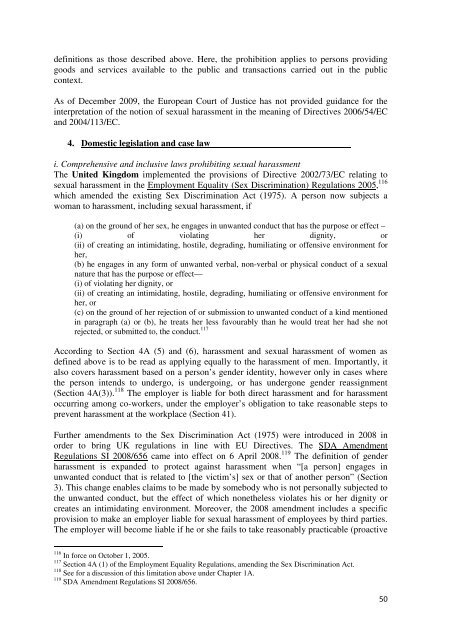Johanna Westeson - The ICHRP
Johanna Westeson - The ICHRP
Johanna Westeson - The ICHRP
You also want an ePaper? Increase the reach of your titles
YUMPU automatically turns print PDFs into web optimized ePapers that Google loves.
definitions as those described above. Here, the prohibition applies to persons providing<br />
goods and services available to the public and transactions carried out in the public<br />
context.<br />
As of December 2009, the European Court of Justice has not provided guidance for the<br />
interpretation of the notion of sexual harassment in the meaning of Directives 2006/54/EC<br />
and 2004/113/EC.<br />
4. Domestic legislation and case law<br />
i. Comprehensive and inclusive laws prohibiting sexual harassment<br />
<strong>The</strong> United Kingdom implemented the provisions of Directive 2002/73/EC relating to<br />
sexual harassment in the Employment Equality (Sex Discrimination) Regulations 2005, 116<br />
which amended the existing Sex Discrimination Act (1975). A person now subjects a<br />
woman to harassment, including sexual harassment, if<br />
(a) on the ground of her sex, he engages in unwanted conduct that has the purpose or effect –<br />
(i) of violating her dignity, or<br />
(ii) of creating an intimidating, hostile, degrading, humiliating or offensive environment for<br />
her,<br />
(b) he engages in any form of unwanted verbal, non-verbal or physical conduct of a sexual<br />
nature that has the purpose or effect—<br />
(i) of violating her dignity, or<br />
(ii) of creating an intimidating, hostile, degrading, humiliating or offensive environment for<br />
her, or<br />
(c) on the ground of her rejection of or submission to unwanted conduct of a kind mentioned<br />
in paragraph (a) or (b), he treats her less favourably than he would treat her had she not<br />
rejected, or submitted to, the conduct. 117<br />
According to Section 4A (5) and (6), harassment and sexual harassment of women as<br />
defined above is to be read as applying equally to the harassment of men. Importantly, it<br />
also covers harassment based on a person’s gender identity, however only in cases where<br />
the person intends to undergo, is undergoing, or has undergone gender reassignment<br />
(Section 4A(3)). 118 <strong>The</strong> employer is liable for both direct harassment and for harassment<br />
occurring among co-workers, under the employer’s obligation to take reasonable steps to<br />
prevent harassment at the workplace (Section 41).<br />
Further amendments to the Sex Discrimination Act (1975) were introduced in 2008 in<br />
order to bring UK regulations in line with EU Directives. <strong>The</strong> SDA Amendment<br />
Regulations SI 2008/656 came into effect on 6 April 2008. 119 <strong>The</strong> definition of gender<br />
harassment is expanded to protect against harassment when “[a person] engages in<br />
unwanted conduct that is related to [the victim’s] sex or that of another person” (Section<br />
3). This change enables claims to be made by somebody who is not personally subjected to<br />
the unwanted conduct, but the effect of which nonetheless violates his or her dignity or<br />
creates an intimidating environment. Moreover, the 2008 amendment includes a specific<br />
provision to make an employer liable for sexual harassment of employees by third parties.<br />
<strong>The</strong> employer will become liable if he or she fails to take reasonably practicable (proactive<br />
116 In force on October 1, 2005.<br />
117 Section 4A (1) of the Employment Equality Regulations, amending the Sex Discrimination Act.<br />
118 See for a discussion of this limitation above under Chapter 1A.<br />
119 SDA Amendment Regulations SI 2008/656.<br />
50
















